Koolin Balit Health Plan Review: Victorian Aboriginal Health 2012-2022
VerifiedAdded on 2023/06/09
|6
|2045
|130
Report
AI Summary
This report provides a comprehensive review of the Koolin Balit: Victorian Government strategic directions for Aboriginal health 2012-2022. The report begins with an introduction explaining the purpose of the health plan review, followed by an overview of the plan's objectives, which aim to improve the health and well-being of Aboriginal communities in Victoria. The report then focuses on the priority area of 'A healthy start to life,' with an emphasis on at-risk groups such as indigenous pregnant women and children. It further discusses the influence of three key social determinants of health: education, social support, and poverty, on the health outcomes of these vulnerable populations. The analysis highlights how these determinants contribute to health disparities and increased maternal and infant mortality rates. The report concludes by summarizing the plan's goals and anticipated outcomes, emphasizing the importance of addressing social determinants to achieve positive health outcomes for Aboriginal communities. The report references various sources to support its analysis.
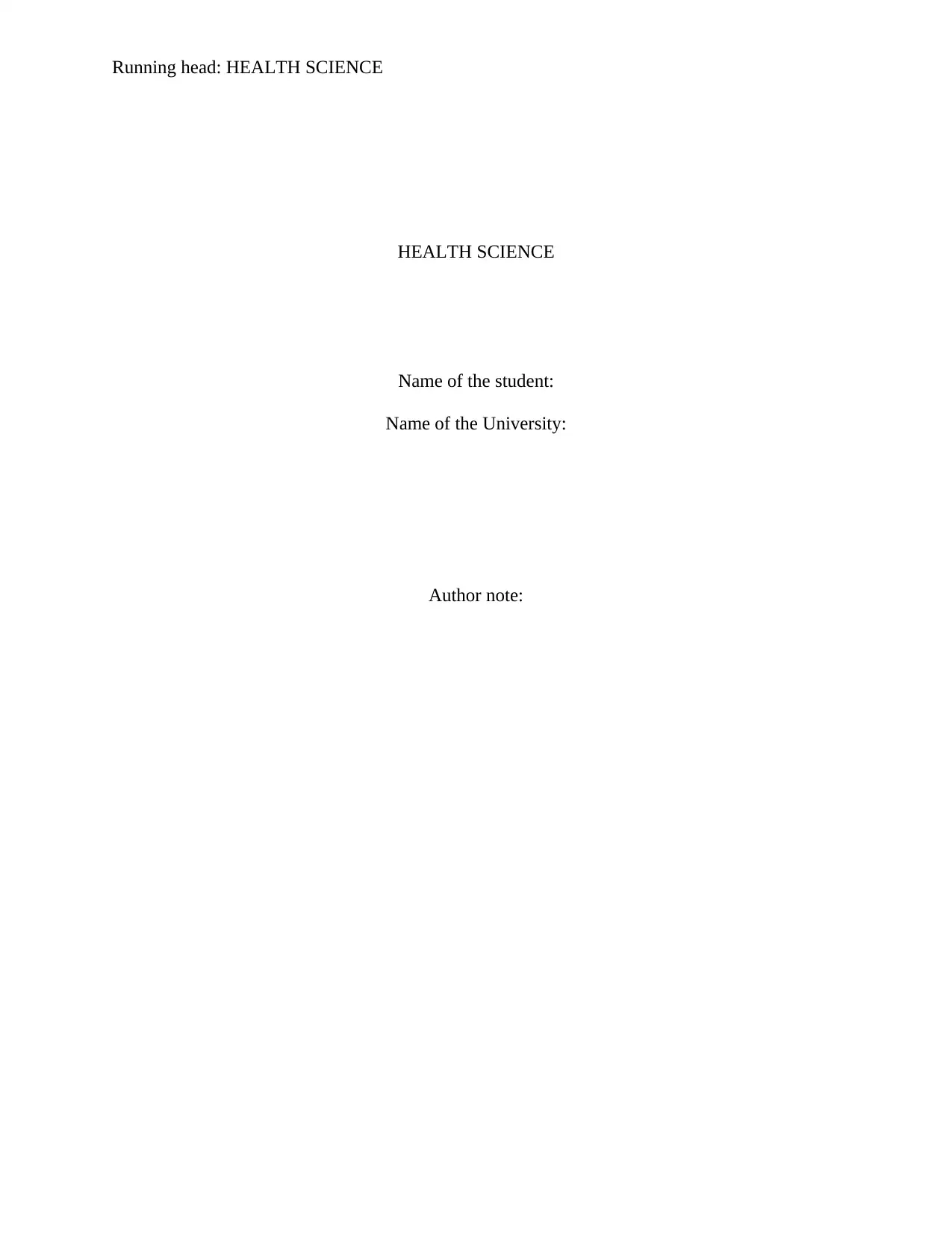
Running head: HEALTH SCIENCE
HEALTH SCIENCE
Name of the student:
Name of the University:
Author note:
HEALTH SCIENCE
Name of the student:
Name of the University:
Author note:
Paraphrase This Document
Need a fresh take? Get an instant paraphrase of this document with our AI Paraphraser
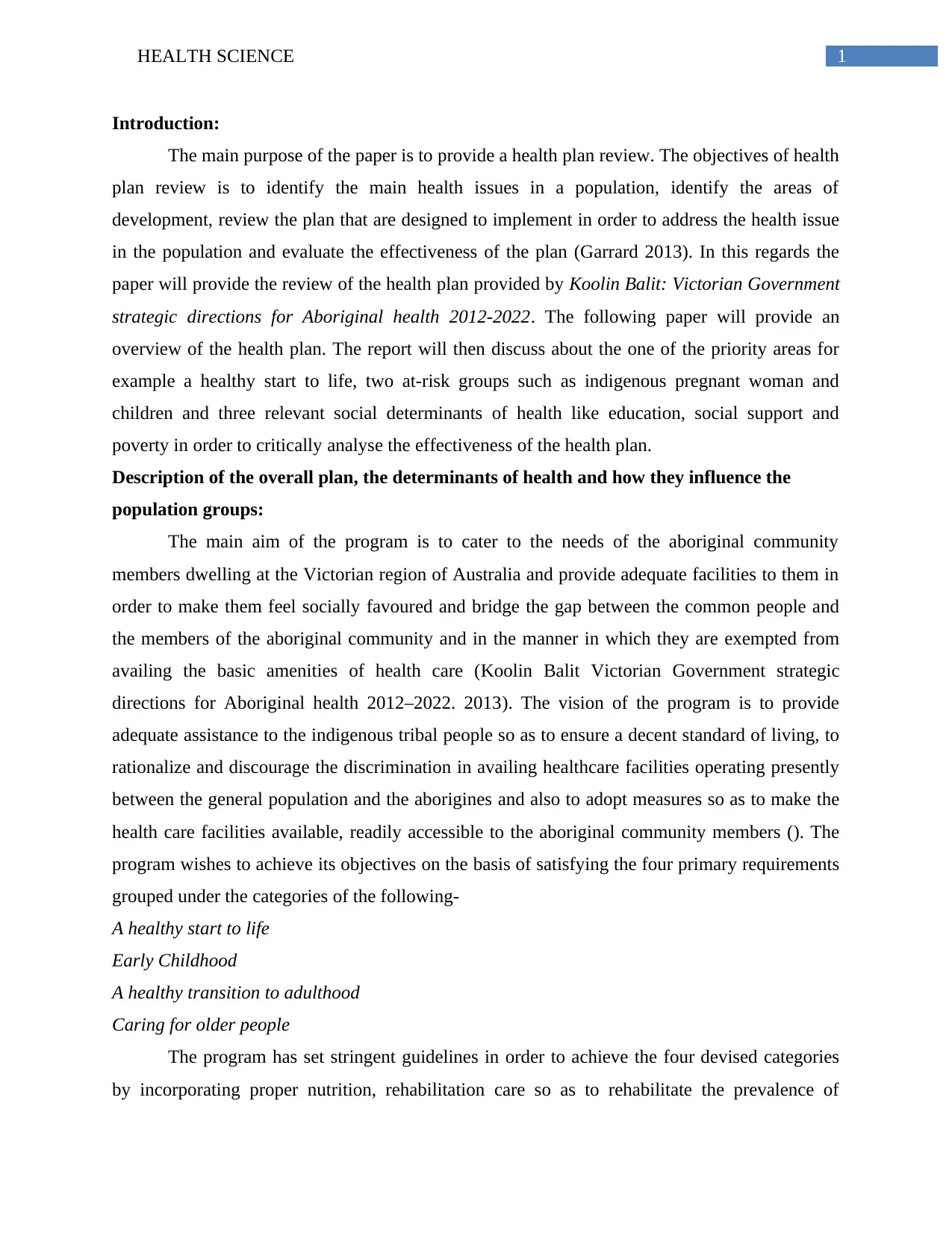
1HEALTH SCIENCE
Introduction:
The main purpose of the paper is to provide a health plan review. The objectives of health
plan review is to identify the main health issues in a population, identify the areas of
development, review the plan that are designed to implement in order to address the health issue
in the population and evaluate the effectiveness of the plan (Garrard 2013). In this regards the
paper will provide the review of the health plan provided by Koolin Balit: Victorian Government
strategic directions for Aboriginal health 2012-2022. The following paper will provide an
overview of the health plan. The report will then discuss about the one of the priority areas for
example a healthy start to life, two at-risk groups such as indigenous pregnant woman and
children and three relevant social determinants of health like education, social support and
poverty in order to critically analyse the effectiveness of the health plan.
Description of the overall plan, the determinants of health and how they influence the
population groups:
The main aim of the program is to cater to the needs of the aboriginal community
members dwelling at the Victorian region of Australia and provide adequate facilities to them in
order to make them feel socially favoured and bridge the gap between the common people and
the members of the aboriginal community and in the manner in which they are exempted from
availing the basic amenities of health care (Koolin Balit Victorian Government strategic
directions for Aboriginal health 2012–2022. 2013). The vision of the program is to provide
adequate assistance to the indigenous tribal people so as to ensure a decent standard of living, to
rationalize and discourage the discrimination in availing healthcare facilities operating presently
between the general population and the aborigines and also to adopt measures so as to make the
health care facilities available, readily accessible to the aboriginal community members (). The
program wishes to achieve its objectives on the basis of satisfying the four primary requirements
grouped under the categories of the following-
A healthy start to life
Early Childhood
A healthy transition to adulthood
Caring for older people
The program has set stringent guidelines in order to achieve the four devised categories
by incorporating proper nutrition, rehabilitation care so as to rehabilitate the prevalence of
Introduction:
The main purpose of the paper is to provide a health plan review. The objectives of health
plan review is to identify the main health issues in a population, identify the areas of
development, review the plan that are designed to implement in order to address the health issue
in the population and evaluate the effectiveness of the plan (Garrard 2013). In this regards the
paper will provide the review of the health plan provided by Koolin Balit: Victorian Government
strategic directions for Aboriginal health 2012-2022. The following paper will provide an
overview of the health plan. The report will then discuss about the one of the priority areas for
example a healthy start to life, two at-risk groups such as indigenous pregnant woman and
children and three relevant social determinants of health like education, social support and
poverty in order to critically analyse the effectiveness of the health plan.
Description of the overall plan, the determinants of health and how they influence the
population groups:
The main aim of the program is to cater to the needs of the aboriginal community
members dwelling at the Victorian region of Australia and provide adequate facilities to them in
order to make them feel socially favoured and bridge the gap between the common people and
the members of the aboriginal community and in the manner in which they are exempted from
availing the basic amenities of health care (Koolin Balit Victorian Government strategic
directions for Aboriginal health 2012–2022. 2013). The vision of the program is to provide
adequate assistance to the indigenous tribal people so as to ensure a decent standard of living, to
rationalize and discourage the discrimination in availing healthcare facilities operating presently
between the general population and the aborigines and also to adopt measures so as to make the
health care facilities available, readily accessible to the aboriginal community members (). The
program wishes to achieve its objectives on the basis of satisfying the four primary requirements
grouped under the categories of the following-
A healthy start to life
Early Childhood
A healthy transition to adulthood
Caring for older people
The program has set stringent guidelines in order to achieve the four devised categories
by incorporating proper nutrition, rehabilitation care so as to rehabilitate the prevalence of
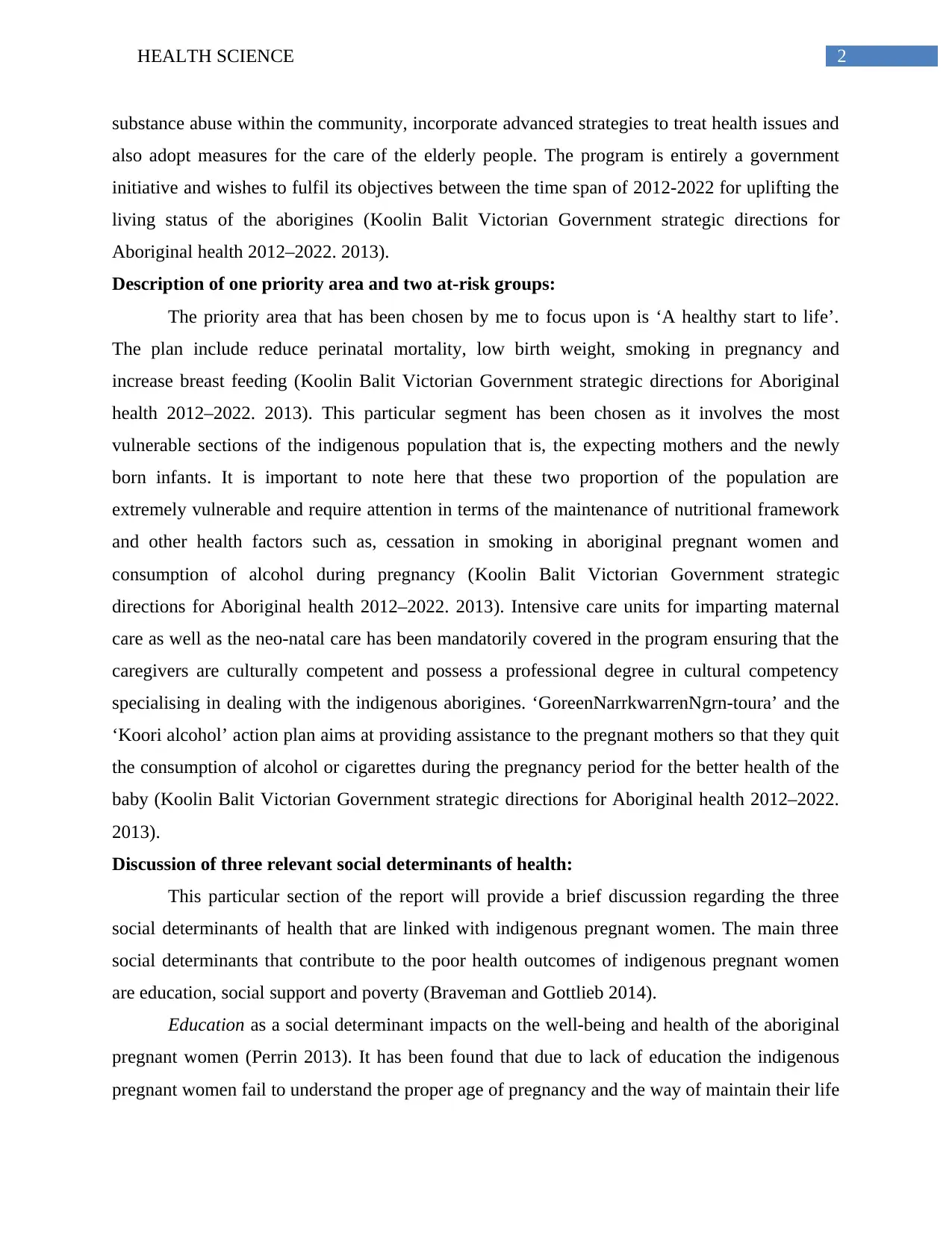
2HEALTH SCIENCE
substance abuse within the community, incorporate advanced strategies to treat health issues and
also adopt measures for the care of the elderly people. The program is entirely a government
initiative and wishes to fulfil its objectives between the time span of 2012-2022 for uplifting the
living status of the aborigines (Koolin Balit Victorian Government strategic directions for
Aboriginal health 2012–2022. 2013).
Description of one priority area and two at-risk groups:
The priority area that has been chosen by me to focus upon is ‘A healthy start to life’.
The plan include reduce perinatal mortality, low birth weight, smoking in pregnancy and
increase breast feeding (Koolin Balit Victorian Government strategic directions for Aboriginal
health 2012–2022. 2013). This particular segment has been chosen as it involves the most
vulnerable sections of the indigenous population that is, the expecting mothers and the newly
born infants. It is important to note here that these two proportion of the population are
extremely vulnerable and require attention in terms of the maintenance of nutritional framework
and other health factors such as, cessation in smoking in aboriginal pregnant women and
consumption of alcohol during pregnancy (Koolin Balit Victorian Government strategic
directions for Aboriginal health 2012–2022. 2013). Intensive care units for imparting maternal
care as well as the neo-natal care has been mandatorily covered in the program ensuring that the
caregivers are culturally competent and possess a professional degree in cultural competency
specialising in dealing with the indigenous aborigines. ‘GoreenNarrkwarrenNgrn-toura’ and the
‘Koori alcohol’ action plan aims at providing assistance to the pregnant mothers so that they quit
the consumption of alcohol or cigarettes during the pregnancy period for the better health of the
baby (Koolin Balit Victorian Government strategic directions for Aboriginal health 2012–2022.
2013).
Discussion of three relevant social determinants of health:
This particular section of the report will provide a brief discussion regarding the three
social determinants of health that are linked with indigenous pregnant women. The main three
social determinants that contribute to the poor health outcomes of indigenous pregnant women
are education, social support and poverty (Braveman and Gottlieb 2014).
Education as a social determinant impacts on the well-being and health of the aboriginal
pregnant women (Perrin 2013). It has been found that due to lack of education the indigenous
pregnant women fail to understand the proper age of pregnancy and the way of maintain their life
substance abuse within the community, incorporate advanced strategies to treat health issues and
also adopt measures for the care of the elderly people. The program is entirely a government
initiative and wishes to fulfil its objectives between the time span of 2012-2022 for uplifting the
living status of the aborigines (Koolin Balit Victorian Government strategic directions for
Aboriginal health 2012–2022. 2013).
Description of one priority area and two at-risk groups:
The priority area that has been chosen by me to focus upon is ‘A healthy start to life’.
The plan include reduce perinatal mortality, low birth weight, smoking in pregnancy and
increase breast feeding (Koolin Balit Victorian Government strategic directions for Aboriginal
health 2012–2022. 2013). This particular segment has been chosen as it involves the most
vulnerable sections of the indigenous population that is, the expecting mothers and the newly
born infants. It is important to note here that these two proportion of the population are
extremely vulnerable and require attention in terms of the maintenance of nutritional framework
and other health factors such as, cessation in smoking in aboriginal pregnant women and
consumption of alcohol during pregnancy (Koolin Balit Victorian Government strategic
directions for Aboriginal health 2012–2022. 2013). Intensive care units for imparting maternal
care as well as the neo-natal care has been mandatorily covered in the program ensuring that the
caregivers are culturally competent and possess a professional degree in cultural competency
specialising in dealing with the indigenous aborigines. ‘GoreenNarrkwarrenNgrn-toura’ and the
‘Koori alcohol’ action plan aims at providing assistance to the pregnant mothers so that they quit
the consumption of alcohol or cigarettes during the pregnancy period for the better health of the
baby (Koolin Balit Victorian Government strategic directions for Aboriginal health 2012–2022.
2013).
Discussion of three relevant social determinants of health:
This particular section of the report will provide a brief discussion regarding the three
social determinants of health that are linked with indigenous pregnant women. The main three
social determinants that contribute to the poor health outcomes of indigenous pregnant women
are education, social support and poverty (Braveman and Gottlieb 2014).
Education as a social determinant impacts on the well-being and health of the aboriginal
pregnant women (Perrin 2013). It has been found that due to lack of education the indigenous
pregnant women fail to understand the proper age of pregnancy and the way of maintain their life
⊘ This is a preview!⊘
Do you want full access?
Subscribe today to unlock all pages.

Trusted by 1+ million students worldwide
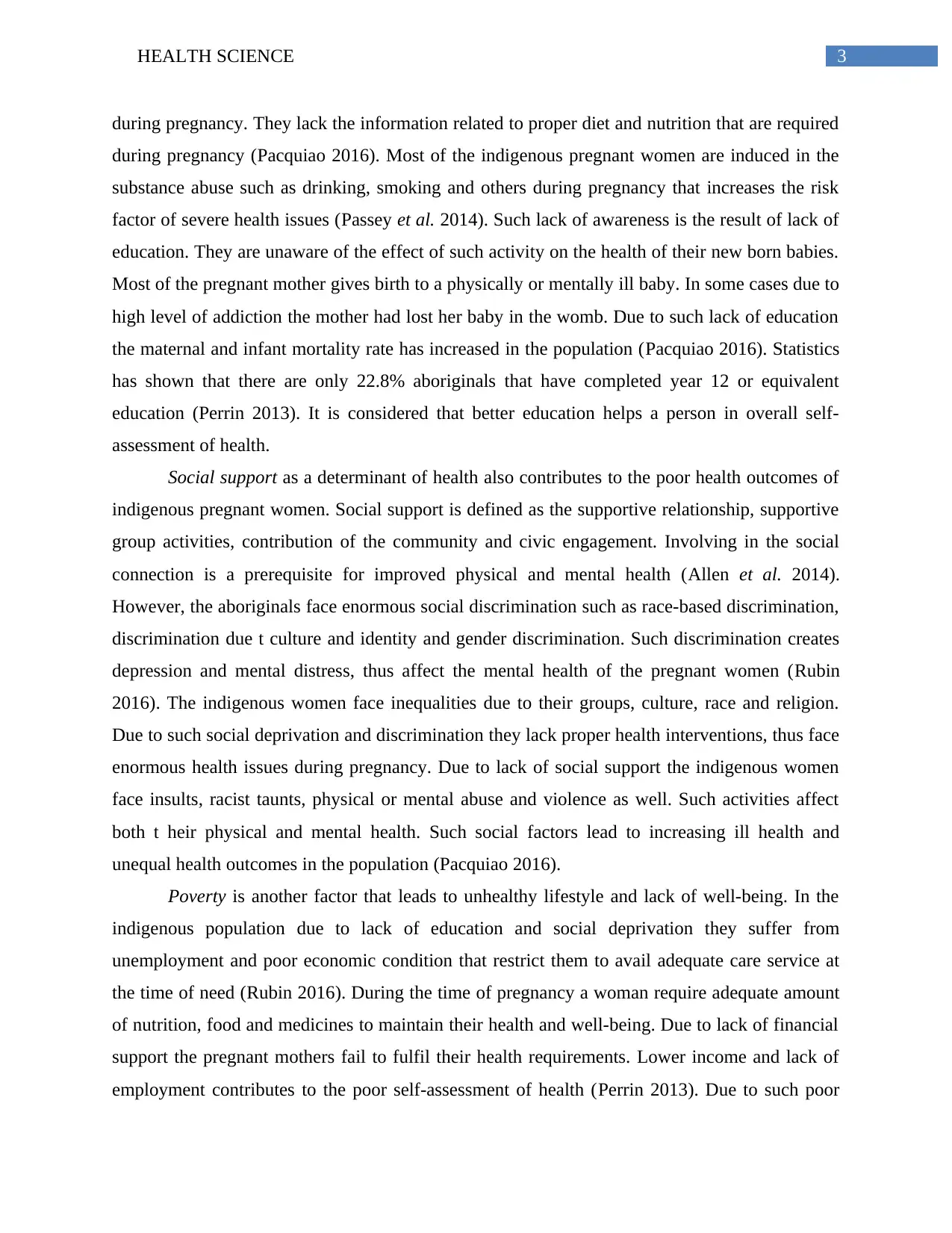
3HEALTH SCIENCE
during pregnancy. They lack the information related to proper diet and nutrition that are required
during pregnancy (Pacquiao 2016). Most of the indigenous pregnant women are induced in the
substance abuse such as drinking, smoking and others during pregnancy that increases the risk
factor of severe health issues (Passey et al. 2014). Such lack of awareness is the result of lack of
education. They are unaware of the effect of such activity on the health of their new born babies.
Most of the pregnant mother gives birth to a physically or mentally ill baby. In some cases due to
high level of addiction the mother had lost her baby in the womb. Due to such lack of education
the maternal and infant mortality rate has increased in the population (Pacquiao 2016). Statistics
has shown that there are only 22.8% aboriginals that have completed year 12 or equivalent
education (Perrin 2013). It is considered that better education helps a person in overall self-
assessment of health.
Social support as a determinant of health also contributes to the poor health outcomes of
indigenous pregnant women. Social support is defined as the supportive relationship, supportive
group activities, contribution of the community and civic engagement. Involving in the social
connection is a prerequisite for improved physical and mental health (Allen et al. 2014).
However, the aboriginals face enormous social discrimination such as race-based discrimination,
discrimination due t culture and identity and gender discrimination. Such discrimination creates
depression and mental distress, thus affect the mental health of the pregnant women (Rubin
2016). The indigenous women face inequalities due to their groups, culture, race and religion.
Due to such social deprivation and discrimination they lack proper health interventions, thus face
enormous health issues during pregnancy. Due to lack of social support the indigenous women
face insults, racist taunts, physical or mental abuse and violence as well. Such activities affect
both t heir physical and mental health. Such social factors lead to increasing ill health and
unequal health outcomes in the population (Pacquiao 2016).
Poverty is another factor that leads to unhealthy lifestyle and lack of well-being. In the
indigenous population due to lack of education and social deprivation they suffer from
unemployment and poor economic condition that restrict them to avail adequate care service at
the time of need (Rubin 2016). During the time of pregnancy a woman require adequate amount
of nutrition, food and medicines to maintain their health and well-being. Due to lack of financial
support the pregnant mothers fail to fulfil their health requirements. Lower income and lack of
employment contributes to the poor self-assessment of health (Perrin 2013). Due to such poor
during pregnancy. They lack the information related to proper diet and nutrition that are required
during pregnancy (Pacquiao 2016). Most of the indigenous pregnant women are induced in the
substance abuse such as drinking, smoking and others during pregnancy that increases the risk
factor of severe health issues (Passey et al. 2014). Such lack of awareness is the result of lack of
education. They are unaware of the effect of such activity on the health of their new born babies.
Most of the pregnant mother gives birth to a physically or mentally ill baby. In some cases due to
high level of addiction the mother had lost her baby in the womb. Due to such lack of education
the maternal and infant mortality rate has increased in the population (Pacquiao 2016). Statistics
has shown that there are only 22.8% aboriginals that have completed year 12 or equivalent
education (Perrin 2013). It is considered that better education helps a person in overall self-
assessment of health.
Social support as a determinant of health also contributes to the poor health outcomes of
indigenous pregnant women. Social support is defined as the supportive relationship, supportive
group activities, contribution of the community and civic engagement. Involving in the social
connection is a prerequisite for improved physical and mental health (Allen et al. 2014).
However, the aboriginals face enormous social discrimination such as race-based discrimination,
discrimination due t culture and identity and gender discrimination. Such discrimination creates
depression and mental distress, thus affect the mental health of the pregnant women (Rubin
2016). The indigenous women face inequalities due to their groups, culture, race and religion.
Due to such social deprivation and discrimination they lack proper health interventions, thus face
enormous health issues during pregnancy. Due to lack of social support the indigenous women
face insults, racist taunts, physical or mental abuse and violence as well. Such activities affect
both t heir physical and mental health. Such social factors lead to increasing ill health and
unequal health outcomes in the population (Pacquiao 2016).
Poverty is another factor that leads to unhealthy lifestyle and lack of well-being. In the
indigenous population due to lack of education and social deprivation they suffer from
unemployment and poor economic condition that restrict them to avail adequate care service at
the time of need (Rubin 2016). During the time of pregnancy a woman require adequate amount
of nutrition, food and medicines to maintain their health and well-being. Due to lack of financial
support the pregnant mothers fail to fulfil their health requirements. Lower income and lack of
employment contributes to the poor self-assessment of health (Perrin 2013). Due to such poor
Paraphrase This Document
Need a fresh take? Get an instant paraphrase of this document with our AI Paraphraser
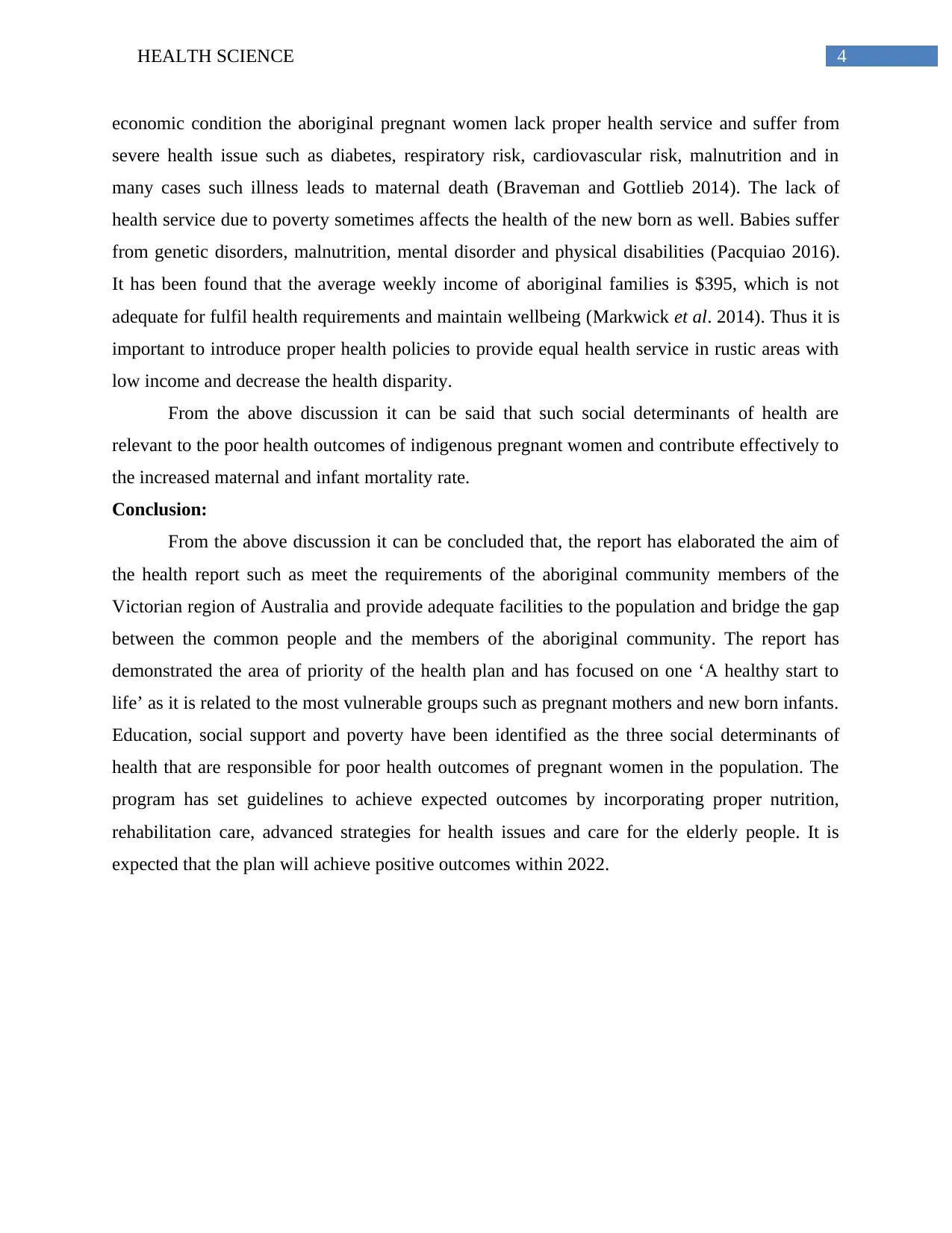
4HEALTH SCIENCE
economic condition the aboriginal pregnant women lack proper health service and suffer from
severe health issue such as diabetes, respiratory risk, cardiovascular risk, malnutrition and in
many cases such illness leads to maternal death (Braveman and Gottlieb 2014). The lack of
health service due to poverty sometimes affects the health of the new born as well. Babies suffer
from genetic disorders, malnutrition, mental disorder and physical disabilities (Pacquiao 2016).
It has been found that the average weekly income of aboriginal families is $395, which is not
adequate for fulfil health requirements and maintain wellbeing (Markwick et al. 2014). Thus it is
important to introduce proper health policies to provide equal health service in rustic areas with
low income and decrease the health disparity.
From the above discussion it can be said that such social determinants of health are
relevant to the poor health outcomes of indigenous pregnant women and contribute effectively to
the increased maternal and infant mortality rate.
Conclusion:
From the above discussion it can be concluded that, the report has elaborated the aim of
the health report such as meet the requirements of the aboriginal community members of the
Victorian region of Australia and provide adequate facilities to the population and bridge the gap
between the common people and the members of the aboriginal community. The report has
demonstrated the area of priority of the health plan and has focused on one ‘A healthy start to
life’ as it is related to the most vulnerable groups such as pregnant mothers and new born infants.
Education, social support and poverty have been identified as the three social determinants of
health that are responsible for poor health outcomes of pregnant women in the population. The
program has set guidelines to achieve expected outcomes by incorporating proper nutrition,
rehabilitation care, advanced strategies for health issues and care for the elderly people. It is
expected that the plan will achieve positive outcomes within 2022.
economic condition the aboriginal pregnant women lack proper health service and suffer from
severe health issue such as diabetes, respiratory risk, cardiovascular risk, malnutrition and in
many cases such illness leads to maternal death (Braveman and Gottlieb 2014). The lack of
health service due to poverty sometimes affects the health of the new born as well. Babies suffer
from genetic disorders, malnutrition, mental disorder and physical disabilities (Pacquiao 2016).
It has been found that the average weekly income of aboriginal families is $395, which is not
adequate for fulfil health requirements and maintain wellbeing (Markwick et al. 2014). Thus it is
important to introduce proper health policies to provide equal health service in rustic areas with
low income and decrease the health disparity.
From the above discussion it can be said that such social determinants of health are
relevant to the poor health outcomes of indigenous pregnant women and contribute effectively to
the increased maternal and infant mortality rate.
Conclusion:
From the above discussion it can be concluded that, the report has elaborated the aim of
the health report such as meet the requirements of the aboriginal community members of the
Victorian region of Australia and provide adequate facilities to the population and bridge the gap
between the common people and the members of the aboriginal community. The report has
demonstrated the area of priority of the health plan and has focused on one ‘A healthy start to
life’ as it is related to the most vulnerable groups such as pregnant mothers and new born infants.
Education, social support and poverty have been identified as the three social determinants of
health that are responsible for poor health outcomes of pregnant women in the population. The
program has set guidelines to achieve expected outcomes by incorporating proper nutrition,
rehabilitation care, advanced strategies for health issues and care for the elderly people. It is
expected that the plan will achieve positive outcomes within 2022.
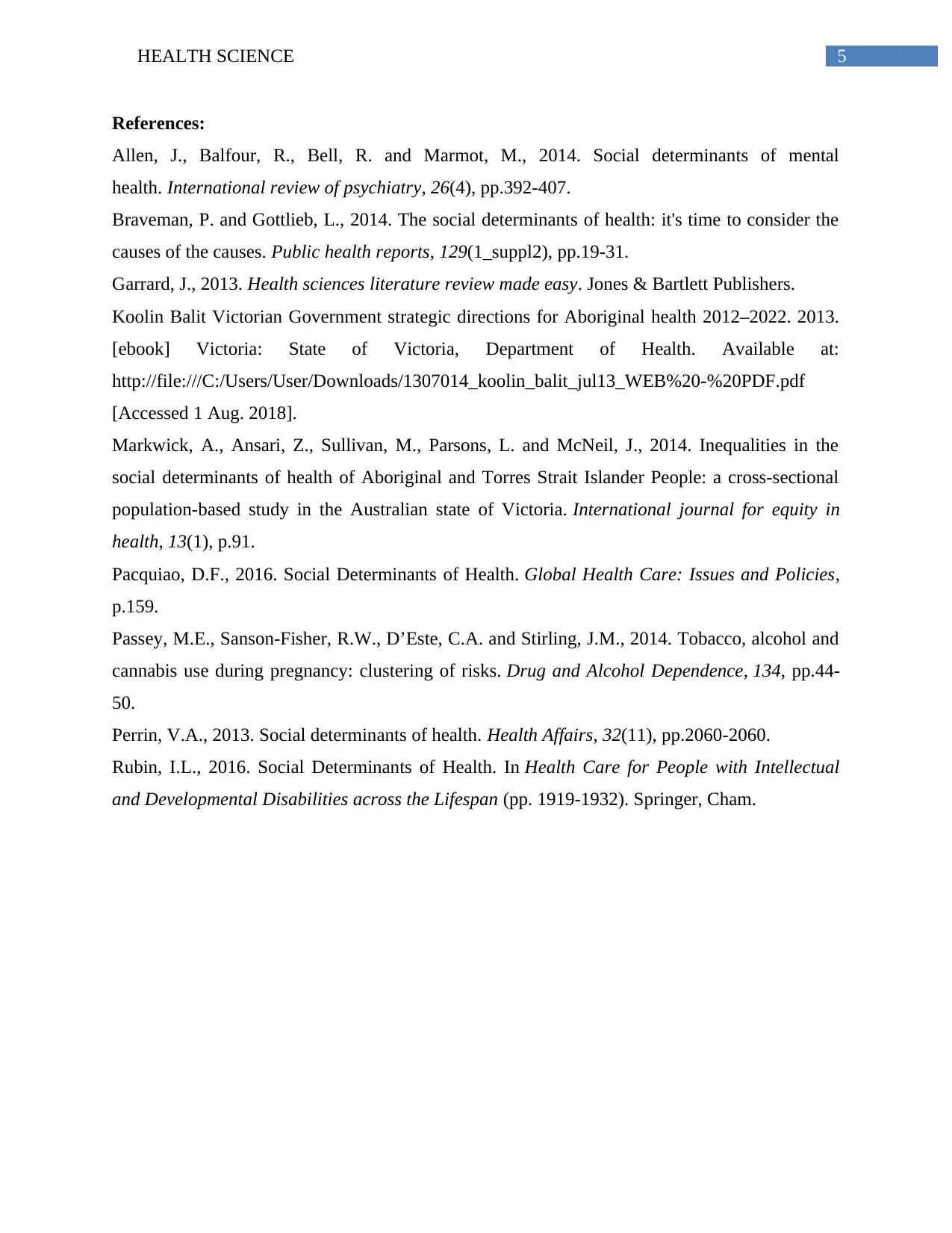
5HEALTH SCIENCE
References:
Allen, J., Balfour, R., Bell, R. and Marmot, M., 2014. Social determinants of mental
health. International review of psychiatry, 26(4), pp.392-407.
Braveman, P. and Gottlieb, L., 2014. The social determinants of health: it's time to consider the
causes of the causes. Public health reports, 129(1_suppl2), pp.19-31.
Garrard, J., 2013. Health sciences literature review made easy. Jones & Bartlett Publishers.
Koolin Balit Victorian Government strategic directions for Aboriginal health 2012–2022. 2013.
[ebook] Victoria: State of Victoria, Department of Health. Available at:
http://file:///C:/Users/User/Downloads/1307014_koolin_balit_jul13_WEB%20-%20PDF.pdf
[Accessed 1 Aug. 2018].
Markwick, A., Ansari, Z., Sullivan, M., Parsons, L. and McNeil, J., 2014. Inequalities in the
social determinants of health of Aboriginal and Torres Strait Islander People: a cross-sectional
population-based study in the Australian state of Victoria. International journal for equity in
health, 13(1), p.91.
Pacquiao, D.F., 2016. Social Determinants of Health. Global Health Care: Issues and Policies,
p.159.
Passey, M.E., Sanson-Fisher, R.W., D’Este, C.A. and Stirling, J.M., 2014. Tobacco, alcohol and
cannabis use during pregnancy: clustering of risks. Drug and Alcohol Dependence, 134, pp.44-
50.
Perrin, V.A., 2013. Social determinants of health. Health Affairs, 32(11), pp.2060-2060.
Rubin, I.L., 2016. Social Determinants of Health. In Health Care for People with Intellectual
and Developmental Disabilities across the Lifespan (pp. 1919-1932). Springer, Cham.
References:
Allen, J., Balfour, R., Bell, R. and Marmot, M., 2014. Social determinants of mental
health. International review of psychiatry, 26(4), pp.392-407.
Braveman, P. and Gottlieb, L., 2014. The social determinants of health: it's time to consider the
causes of the causes. Public health reports, 129(1_suppl2), pp.19-31.
Garrard, J., 2013. Health sciences literature review made easy. Jones & Bartlett Publishers.
Koolin Balit Victorian Government strategic directions for Aboriginal health 2012–2022. 2013.
[ebook] Victoria: State of Victoria, Department of Health. Available at:
http://file:///C:/Users/User/Downloads/1307014_koolin_balit_jul13_WEB%20-%20PDF.pdf
[Accessed 1 Aug. 2018].
Markwick, A., Ansari, Z., Sullivan, M., Parsons, L. and McNeil, J., 2014. Inequalities in the
social determinants of health of Aboriginal and Torres Strait Islander People: a cross-sectional
population-based study in the Australian state of Victoria. International journal for equity in
health, 13(1), p.91.
Pacquiao, D.F., 2016. Social Determinants of Health. Global Health Care: Issues and Policies,
p.159.
Passey, M.E., Sanson-Fisher, R.W., D’Este, C.A. and Stirling, J.M., 2014. Tobacco, alcohol and
cannabis use during pregnancy: clustering of risks. Drug and Alcohol Dependence, 134, pp.44-
50.
Perrin, V.A., 2013. Social determinants of health. Health Affairs, 32(11), pp.2060-2060.
Rubin, I.L., 2016. Social Determinants of Health. In Health Care for People with Intellectual
and Developmental Disabilities across the Lifespan (pp. 1919-1932). Springer, Cham.
⊘ This is a preview!⊘
Do you want full access?
Subscribe today to unlock all pages.

Trusted by 1+ million students worldwide
1 out of 6
Related Documents
Your All-in-One AI-Powered Toolkit for Academic Success.
+13062052269
info@desklib.com
Available 24*7 on WhatsApp / Email
![[object Object]](/_next/static/media/star-bottom.7253800d.svg)
Unlock your academic potential
Copyright © 2020–2025 A2Z Services. All Rights Reserved. Developed and managed by ZUCOL.





